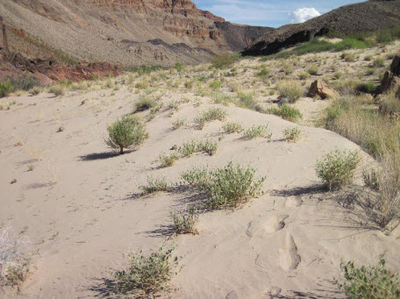Difference between revisions of "Aeolian Sand Transport"
From Glen Canyon Dam AMP
Cellsworth (Talk | contribs) |
Cellsworth (Talk | contribs) |
||
| (4 intermediate revisions by the same user not shown) | |||
| Line 70: | Line 70: | ||
|- | |- | ||
|style="color:#000;"| | |style="color:#000;"| | ||
| + | |||
| + | '''2023''' | ||
| + | *[https://doi.org/10.1016/j.geomorph.2023.109021 Caster et al. 2024, Do topographic changes tell us about variability in aeolian sediment transport and dune mobility? Analysis of monthly to decadal surface changes in a partially vegetated and biocrust covered dunefield: Geomorphology, v. 447, p. 1-16] | ||
| + | *[https://www.sciencedirect.com/science/article/pii/S0301479723008241?via%3Dihub Sankey et al. 2023. Archaeological sites in Grand Canyon National Park along the Colorado River are eroding owing to six decades of Glen Canyon Dam operations] | ||
| + | |||
| + | '''2022''' | ||
| + | *[https://www.usbr.gov/uc/progact/amp/twg/2022-01-13-twg-meeting/20220113-AnnualReportingMeeting-ProjectDGeomorphicEffectsDamOperationsVegetationManagementArchaeologicalSites-508-UCRO.pdf Project D: Geomorphic Effects of Dam Operations and Vegetation management on Archaeological Sites ] | ||
| + | |||
| + | '''2021''' | ||
| + | *[https://www.usbr.gov/uc/progact/amp/amwg/2021-02-11-amwg-meeting/20210211-SandSupplyTransportDeposition-508-UCRO.pdf Sand Supply, Transport and Deposition Using Repeat Photography to Document Dam Operation Effects on Sand Supply, Aeolian Landscapes, and Terrestrial Ecology in the Colorado River Ecosystem ] | ||
| + | *[https://www.usbr.gov/uc/progact/amp/twg/2021-01-22-twg-meeting/20210122-AnnualReportingMeeting-UsingRepeatPhotographyDocumentDamOperationEffects-508-UCRO.pdf ] | ||
'''2020''' | '''2020''' | ||
Latest revision as of 14:21, 5 January 2024
|
|
Aeolian Sand TransportSand can potentially help preserve archaeological features by direct burial and/or by mitigating gullying and other erosion. Sand can be deposited on archaeological features or within gullies via fluvial (river) or aeolian (wind) deposition. Most archaeological sites are above the highest contemporary river stage, so aeolian deposition is the most likely mechanism for preservation and/or erosion mitigation. River-sourced sand deposition is a time-dependent process, and the outer limit of that process may extend for many years after any individual HFE. Additionally, HFEs with targeted vegetation removal could produce a net sediment surplus at some sites. [1] |
| --- |
--- |
--- |
|---|


